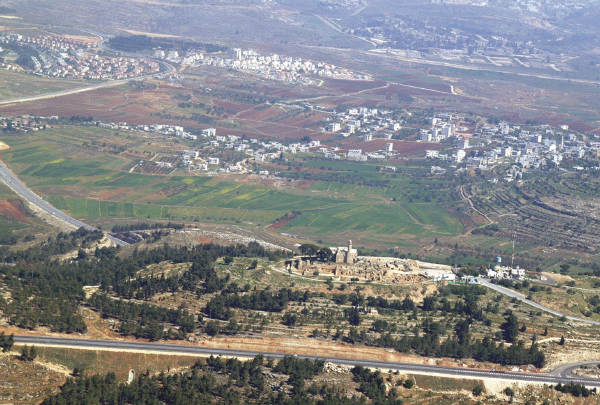God’s Blessing on a Wise, Effective King (3:1–15)
Solomon made an alliance with Pharaoh king of Egypt and married his daughter (3:1). In antiquity treaties and alliances between monarchs were often consummated through an exchange of daughters as wives. Israel’s new dominance in the region led to a series of alliances and hence a large number of wives for Solomon (11:1). The marriage to Pharaoh’s daughter was significant because the powerful Egyptians had seldom been in a weak enough position to derive benefit from giving their women to other monarchs. In keeping with this prestigious acquisition, Solomon built his bride a palace (7:8). The dowry included the site of Gezer, located near Joppa at an all-important crossroads between the road into Jerusalem and the international trunk route spanning the coast of Israel from Egypt to Syria and on to Mesopotamia.59
Archaeologists have unearthed a large Israelite city wall, gate, and other structures that Solomon built at this time (see 9:15). During this period of waning Egyptian influence, the Twenty-First Dynasty, one of Libyan descent, ruled Egypt from Tanis in the delta. When the dates of Solomon (970 to 930 B.C.) are correlated with Egyptian chronology, Siamun emerges as the pharaoh who forged this alliance with Solomon.60 Effectively, in a rare anomaly of history, the Israelites under Solomon displaced the mighty pharaoh’s hegemony of the southern Levant and its all-important trade routes. Indeed, only a few decades later the Egyptians attempted to disrupt Israelite supremacy in the region through the campaign of Pharaoh Shishak in 927 B.C.
Solomon offered a thousand burnt offerings on that altar (3:4). Such a large number of offerings must represent a momentous moment in Israel’s history (cf. 8:63). There is no reason to doubt this number because comparable numbers occur in other ancient Near Eastern texts and in this case the Hebrew verb for sacrifice can mean ongoing sacrifice over time.61 Some scholars compare this passage to Deuteronomy 1:11, in which the number one thousand appears to convey the idea of “a great many.”
Gibeon (3:5). The city is located at modern el-Jib, roughly three and a half miles north of Jerusalem, on a broad plateau atop the Judean range. Since the day of Joshua’s skirmish with the Gibeonites, it dominated the strategic highland crossroads from where one could travel west to the coast of the Mediterranean, east to Jericho and Transjordan, south to Jerusalem and Hebron, or north to Shechem (Josh. 10).62 Because of its position at the most convenient ascent from the Mediterranean coast, it witnessed countless military campaigns from pharaohs to Romans, Crusaders, and modern British. The nearby hill of Nebi-Samwil affords a view of Canaan, including Jerusalem.63 This is no doubt the high place of Gibeon where Solomon sacrificed over a thousand animals on the ancient altar, had his dream, and visited the Tent of Meeting that David had erected there (1 Chron. 21:29; 2 Chron. 1:3–13).

Nebi Samwil can be identified by the tower in the center of the picture and Gibeon is at center right.
© PBT & © James C. Martin
At Gibeon the LORD appeared to Solomon during the night in a dream (3:5). High places and shrines were places of reflection, seeking, and in some instances lodging and theophany. Dream narratives are common in ancient Near Eastern literature, especially among kings facing new challenges. Thus King Gudea of third millennium Mesopotamia received instruction to build a temple to Ningirsu and place the statues of the deity inside, an Egyptian pharaoh Netjer-er-khet was warned of impending famine, Amenhotep II received battle plans from the god Amon, and King Kirta of Ugarit gained instruction for conquest and personal restoration from the deity ʿIlu.64
Solomon’s dream fits a well-known pattern of “incubation dreams,” in which divine revelation guides and assures the hero through key moments in personal and national history.65 The account of Solomon’s dream also fits its immediate Syro-Palestinian cultural context.66
You have made your servant king (3:7). Like David before him, Solomon was sponsored by Yahweh. One text among many that portrays divine backing for a king is the monumental inscription from Tel Dan in which an Aramean king boasts of his god, Hadad, making him king and “going forth before” him.67 The kings of Israel spoke of their divinely sponsored acts with the same conventions used by monarchs in surrounding lands.

Pharaoh being granted authority and support by the gods, from the Ramesseum
Manfred Näder, Gabana Studios, Germany
Discerning heart (3:12). Solomon’s appeal for wisdom and the Lord’s promise of wealth and long life could be taken from the pages of any Near Eastern king. Note, for example, the prayer for the Assyrian king Tukulti-Ninurta I, a century before Solomon: “May Assur give you authority, obedience, concord, justice, and peace!”68
